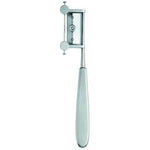
£556.78 GBP inc. VAT
The Silvers stainless steel "miniature" skin graft handle, featuring a unique blue design, was initially created by H.L. Silver in Toronto, Canada.
Paired with our surgical-grade double-edged razor blades, it is ideal for obtaining small, detailed grafts from areas that are challenging to reach with larger standard knives, such as the ear, back of the hands, or scalp.
Primarily utilized in Plastic, Reconstructive, and Oral surgery, the Silver's handle is also effective for wound debridement.
Instructions for Use *:
1) Under sterile conditions, carefully insert the blade into the handle, ensuring the cutting edge is not damaged by contact with metal. Exercise caution to avoid injury, as the blade is extremely sharp.
2) Attach the blade retaining plate, noting its asymmetrical design. The shorter section should cover the free blade edge. Incorrect placement can cause the retaining plate to strike the handle body near the blade's lateral free edges.
3) Secure the blade in the handle by inserting and tightening the fixing nut.
4) Adjust the two thumb screws on each side of the handle to set the desired graft thickness. These screws move the harvesting guide closer to or further from the blade, altering the graft thickness. Ensure the blade remains parallel to the harvesting guide by turning the thumb screws equally.
5) Split thickness grafts range from thin (0.008 inches) to medium (0.010 inches) to thick (0.012 inches).
6) A Swann-Morton No.15 scalpel blade can be used to verify the selected thickness before graft harvesting. The No.15 blade measures 0.394mm or 0.0155 inches. If it passes freely between the skin graft blade and the harvesting guide, a thick split thickness graft is achieved, suitable for areas like the anterior or lateral upper thigh.
7) For the forearm or arm, choose a thin to medium thickness graft. The No.15 blade will only partially pass to the bevel. The recipient site dictates the desired graft thickness.
8) After administering appropriate anesthesia and applying lubrication, such as liquid paraffin, to the donor site and skin graft knife, harvest the graft by moving the blade steadily back and forth while stretching the skin to keep it taut.
Free Engraving Available!
Personalize Your Littmann Stethoscope with Free Engraving! Make It Uniquely Yours Today.
Use code 'FREE' at checkout.



